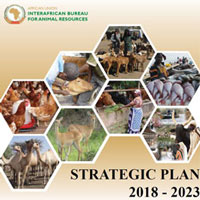AU-IBAR Strategic Plan 2018-2023
The AU-IBAR Strategic Plan 2018-2023 builds on lessons learnt from the review of the implementation of its predecessor Strategic Plan 2014-2017. The review was conducted in close consultation with African Union Member States (MSs), Regional Economic Communities (RECs), and AU-IBAR’s key Development Partners (DPs); and its findings were discussed with key officials at the AU Department of Rural Economy and Agriculture (DREA), and presented to the AU-IBAR Advisory Committee chaired by the African Union Commission (AUC) Commissioner for Rural Economy and Agriculture (REA) and also attended by the Director of DREA as well as representatives of RECs and Development Partners.

This Strategic Plan is aligned to the major goals, objectives and key priority areas of the First Ten-Year Implementation Plan of Agenda 2063’s Mid Term Plan 2018-2023 and the DREA Strategic Plan 2018-2023. Indeed, the plan specifically responds to two Agenda 2063 aspirations that are of direct relevance to the Animal Resources Sector.
These are:
- Aspiration 1: A prosperous Africa based on inclusive growth and sustainable development
- Aspiration 6: An Africa whose development is people-driven, relying on the potential of African People, especially its women and youth, and caring for children.
The plan also focuses on the targets for implementing the AU reform agenda and is guided by the Malabo Declaration commitments with direct impact on the Animal Resources Sector aimed at attaining food and nutrition security; reducing poverty; boosting intra-African trade; enhancing resilience to climate change, related shocks and disasters in Africa. Furthermore, the plan draws from three existing livestock policy frameworks, namely: the Livestock Development Strategy for Africa (LiDeSA), the Policy Framework and Reform Strategy for Fisheries and Aquaculture in Africa and the Policy Framework for Pastoralism in Africa.
Animal Resources in Africa: Opportunities and Challenges
Animal resources are important strategic livelihood and commercial assets for the mostly rural population (who make up to 70% of the African population), and for marketing and trade. Africa’s population currently stands at 1.3 billion, and with a high population growth rate of 2.5%, there is an urgent need to enhance the capabilities necessary for transforming Africa’s mostly subsistent agriculture into commercial enterprise. This will address the increasing demand for food and promote economic and social growth for the mostly rural and poor populations living predominantly as smallholder farmers, herders and fisher-folks.
As in the crops sub-sector, the livestock and fisheries sub-sectors are challenged by three major productivity-limiting obstacles, viz.: a lack of access to formal financial services, poor infrastructure, and lack of sufficient public and private sector investments. Similarly, the wildlife sub-sector is characterized with rudimentary harvesting and management systems that in most situations are
based on illegal practices. As a result, the full production and market potential of the African animal resources sector remains largely under-exploited
